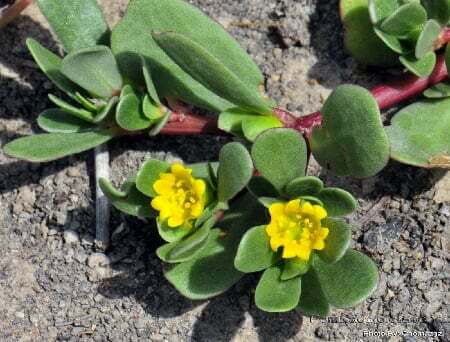We all know Portulaca oleracea as a weed, always popping up through the paving and littering the garden beds, but I bet you didn’t know what a wonder weed this bad boy actually is.
About this gem of a plant:
Purslane botanically known as Portulaca oleracea is also called Pigweed, garden purslane, pusley, pussley, poselien, misbredie, postelein. Oleracea just means `of the vegetable garden or hutch’. Because of its nutritional value it would have been planted in a Potager garden where the herbs and vegetables grew together in the same beds.
DESCRIPTION:
A low growing succulent annual, which can sometimes also be a biennial. There are many other species and most of them are known to also be edible. It grows to a height of about 20cms and up to 30 cms in diameter. The stems stand upright and they are red. The thick, oval, fleshy leaves can grow up to 4 cms in length. The flowers are tiny and pale yellow with five petals and 2 sepals. There are numerous tiny black seeds which are very quick to self sow. The plants require well drained, even sandy, soil with ample watering and they will grow in full sun. Leaves and stems can be generally harvested after 6 to 8 weeks. To harvest the seeds, spread the entire mature plants on paper to dry for a few days. Put through a sieve to collect the dried seeds.
HISTORY:
Pliny the Elder, the botanist, wrote of this plant in 79AD. The plant originated in Roman times and was taken to the United States of America in the 1700s. C Louis Leipoldt also wrote of this plant in his book `Leipoldt’s Cape Cookery’.
BELIEFS:
The ancient peoples believed that the plant would guard off evil spirits. It was strewn on the floor around their beds for protection.
Medicinal and Culinary uses of Portulaca oleracea.
CULINARY
The taste of the leaves is similar to that of freshly cooked asparagus. The raw leaves have a slight sweet/sour flavour. The plant is also eaten by the Tswane tribe, were it is added to spinach dishes. It is widely eaten raw in salads, blanched and cooked with shredded cabbage. One can pickle the stems and eat in salads, add leaves and stems to soups, steam the leaves as a vegetable, use them as a garnish , The pickled stems are great served as winter salads This plant is added to Fattoush a Middle Eastern salad. In China it is boiled and mixed with herbs as a vegetable. The Aborigines harvest, dry and grind the seeds to make a paste and use it for baking as a flour substitute. Similar to cornflour. In France it is included in the classic Bonne Femme soup. The Mexicans use the fresh leaves as a side dish to accompany meals.
It is best eaten raw or just stir fried. Do not cook all the goodness out of the leaves. In Holland I used to make a pickled salad for winter. The dried seeds can be used as a poppy seed replacement in baking. They can also be added to granola. Also be ground into a flour substitute. Add the fresh leaves to a yoghurt and cucumber salad, or a potato salad. Add to your daily smoothies. What in the good old days we called `Raw juice Therapy’ See John B Lusts books. What an eyeopener to a wonderful plant which most people pull out of their gardens and discard! Please consider growing a patch of it next time.
MEDICINAL
The plants are high in vitamin C and they were eaten to prevent scurvy by sailors.
It also has health properties in helping certain diseases of the colon, liver, spleen and large intestine. The leaves can be held under the tongue to allay thirst. The bruised leaves can also be placed over closed eyelids to ease inflamed eyes. This plant is high in vitamin A, B1, C and E. As well as kalium, mucilage, sugars, calcium, beta carotene, (actually containing up to 7 times as much as a carrot does), phosphorus, riboflavin, coenzyme Q10 and iron. The high content of Omega 3 is ideal for those with a vegan and vegetarian lifestyle, and this can help to prevent heart disease and it also nourish the entire bodily system in general.
The plants do contain oxalic acid, like many of the other leafy vegetables., if the leaves are eaten raw. Cooking actually breaks down most of the oxalates. It acts as a diuretic, lowers blood pressure, is helpful for certain lung diseases. It is used in the treatment of diabetes in Africa, India and Europe in certain forms of medication.
Externally it can be used as a wash, as it is a febrifuge. Which means that it can help to break a fever. Also in this manner for skin problems, boils and abscesses.
Other medicinal and healing properties of the plant are alterative, bacteriocide, antiphyretic, antidote, antidysenteric and antiphlogistic. It is also a strong antioxidant. The plant is low in calories and rich in dietary fibre, it is also beneficial for ADHD, autism and can help to prevent a stroke. Use the bruised broken fresh leaves directly for light skin burns and stings.
You can chew a few of the leaves to aid digestion, just as you would do with mint or parsley. The soothing mucilage in the plant is good for gastro intestinal problems. In Europe it is used to make a cough syrup. It is the richest known plant source of Omega 3, in fact it is higher in Omega 3 than a lot of the fish oils.
In America it is used to treat arthritis in horses. Chickens and other farm animals in general love to graze on this plant, too.
Rather avoid eating this wonderful weed if you are suffering from rheumatoid arthritis, arthritis, gout, kidney stones or have a hyperacidity level. Of course, you always have to consult with your medical practitioner if you plan to use this medicinally. I am hoping that you will see if as a very beneficial vegetable now instead of a nuisance `weed’.
It is advisable to add the fresh leaves and stems to a little cotton bath bag added to water to scent the water. This prevents having to scoop the used plant material out of the bath afterwards. This method is good for lowering a fever. However, this is not to be done during pregnancy.
| Article contributed by: Patsy Vergeer from patsy’s potions and the herb and indigenous plant guild. Visit her here.  |






























